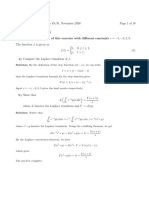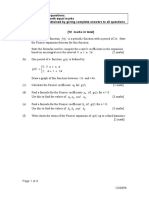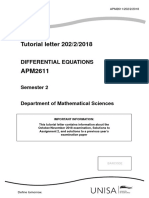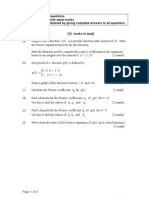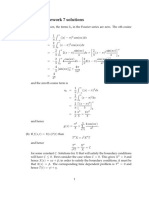Assignment 04
Uploaded by
Muntaha Rahman MayazAssignment 04
Uploaded by
Muntaha Rahman MayazAssignment 4
This assignment, taken from the exercises in Unit 4, is worth 7.5% of your grade.
We recommend that you hand it in after you complete Unit 4. You must show all of
your work in order to obtain full marks. For your convenience, each exercise
mentions the section of the Study Guide that corresponds to the given problem.
Note: Each of the questions below is of equal weight, and each will be marked out
of twenty (20) points. Remember, to gain full marks, you must show your work.
Section 4.1 1. a. Let F[f (x)] = F (ω) and F −1 [F (ω)] denote the Fourier transform of f (x)
and inverse Fourier transform of F (ω), respectively.
i. Show that the Fourier transform is a linear operator; that is, show that
F[c1 f (x) + c2 g(x)] = c1 F (ω) + c2 F (ω).
ii. Show that the inverse Fourier transform is a linear operator; that is, show
that
F −1 [c1 F (ω) + c2 G(ω)] = c1 f (x) + c2 g(x).
b. If F (ω) is the Fourier transform of f (x), show that the inverse Fourier
transform of eiωβ F (ω) is f (x − β).
Note: This result is known as the “shift theorem” for the Fourier transforms.
Section 4.2 2. a. Solve the diffusion equation with convection:
2
∂u = k ∂ u + c ∂u − ∞ < x < ∞
∂t ∂x2 ∂x
u(x, 0) = f (x).
Hint: Apply the Fourier transform and then use the convolution theorem and
shift theorem presented in part (b) of the previous question.
b. Sketch the solution u(x, t) found in part (a) of the previous question for
t = 1, t = 2, and t = 3 given that c = 2, k = 1, and the initial condition
f (x) = δ(x), where δ(x) is the Dirac delta function.
∂u
Also, make a brief comment on the effect of the convection term, c , on the
∂x
solution.
Hint: Use the same idea found in the eText (page 452) when considering the
Dirac delta function δ(x) to find the fundamental solution of the heat
equation.
Sections 4.3 3. a. Find the inverse Fourier sine and cosine transforms of F (ω), given that
and 4.4
F (ω) = e−ωβ , β > 0, (ω ≥ 0).
b. Find the Fourier sine and cosine transforms of f (x), given that
f (x) = e−αx , α > 0, (x ≥ 0).
c. Use the definition of the Laplace transform (i.e., use the explicit integration),
to find the Laplace transform of the functions f (t) = 1 and f (t) = eat .
Partial Differential Equations 1
Section 4.3 4. Choose only and appropriately between the Fourier sine transform and the
Fourier cosine transform to solve
∂u ∂2u
= k 2, x > 0
∂t ∂x
u(x, 0) = f (x)
∂u (0, t) = 0.
∂x
Section 4.5 5. Use the Laplace transform to solve
2
∂ u ∂2u
2
= c2 2 , −∞ < x < ∞
∂t ∂x
u(x, 0) = sin x , ∂u (x, 0) = 0.
∂t
2 Mathematics 476
You might also like
- Question Bank Electrical Engineering Makerere UniversityNo ratings yetQuestion Bank Electrical Engineering Makerere University367 pages
- Homework 6: AMATH 353 Partial Differential Equations and Waves Weston Barger Summer 2016No ratings yetHomework 6: AMATH 353 Partial Differential Equations and Waves Weston Barger Summer 20162 pages
- MA7154 AdvancedMathematicalMethodsquestionbankNo ratings yetMA7154 AdvancedMathematicalMethodsquestionbank10 pages
- Chapter 4 - Solved Problems: Solutions To Solved Problem 4.1No ratings yetChapter 4 - Solved Problems: Solutions To Solved Problem 4.112 pages
- Heat Equation Solution Using Fourier TransformNo ratings yetHeat Equation Solution Using Fourier Transform2 pages
- Answers of The Exam of November 1, 2013 Differential Equations (wi2180LR)No ratings yetAnswers of The Exam of November 1, 2013 Differential Equations (wi2180LR)8 pages
- Math 121A: Solutions To Final Exam: AnswerNo ratings yetMath 121A: Solutions To Final Exam: Answer12 pages
- Delft University of Technology Faculty of Elec. Eng, Mathematics and Comp. SCNo ratings yetDelft University of Technology Faculty of Elec. Eng, Mathematics and Comp. SC2 pages
- QUESTION BANK - (Laplace and Fourier Transform - CUTM1002)No ratings yetQUESTION BANK - (Laplace and Fourier Transform - CUTM1002)7 pages
- Common Pre-Final Examination - Feb, 201 III B.SC Degree ExaminationNo ratings yetCommon Pre-Final Examination - Feb, 201 III B.SC Degree Examination3 pages
- F T Is A Periodic Function With A Period of 2No ratings yetF T Is A Periodic Function With A Period of 25 pages
- Faculty of Engineering and Technology Model Question Paper - B. TechNo ratings yetFaculty of Engineering and Technology Model Question Paper - B. Tech5 pages
- Fourier Series, Generalized Functions, Laplace TransformNo ratings yetFourier Series, Generalized Functions, Laplace Transform6 pages
- University of Zimbabwe: Lecturer: S. Maungira Department: MathematicsNo ratings yetUniversity of Zimbabwe: Lecturer: S. Maungira Department: Mathematics5 pages
- Fluid Mechanics - 100 Problems-CompressedNo ratings yetFluid Mechanics - 100 Problems-Compressed26 pages
- Probability, Statistics & Queueing Theory (R22a0026)No ratings yetProbability, Statistics & Queueing Theory (R22a0026)120 pages
- Light Reflection and Refraction Class 10 Numerica…No ratings yetLight Reflection and Refraction Class 10 Numerica…1 page
- 440 HTZ OU 432 HTZ .... VIBRAÇÕES, PerigosNo ratings yet440 HTZ OU 432 HTZ .... VIBRAÇÕES, Perigos2 pages
- Industrial Products Division: Kurashiki Kako Co., Ltd. Kurashiki Kako Co., LTDNo ratings yetIndustrial Products Division: Kurashiki Kako Co., Ltd. Kurashiki Kako Co., LTD32 pages
- Massively Parallel Amplitude-Only Fourier Neural NetworkNo ratings yetMassively Parallel Amplitude-Only Fourier Neural Network8 pages
- Learner Guide Cambridge International AsNo ratings yetLearner Guide Cambridge International As37 pages
- Fiitjee All India Test Series: JEE (Main) - 2021No ratings yetFiitjee All India Test Series: JEE (Main) - 202119 pages
- 1 - PHYS 204 - Course Outline - Fall 2022-Section - 01No ratings yet1 - PHYS 204 - Course Outline - Fall 2022-Section - 0114 pages











